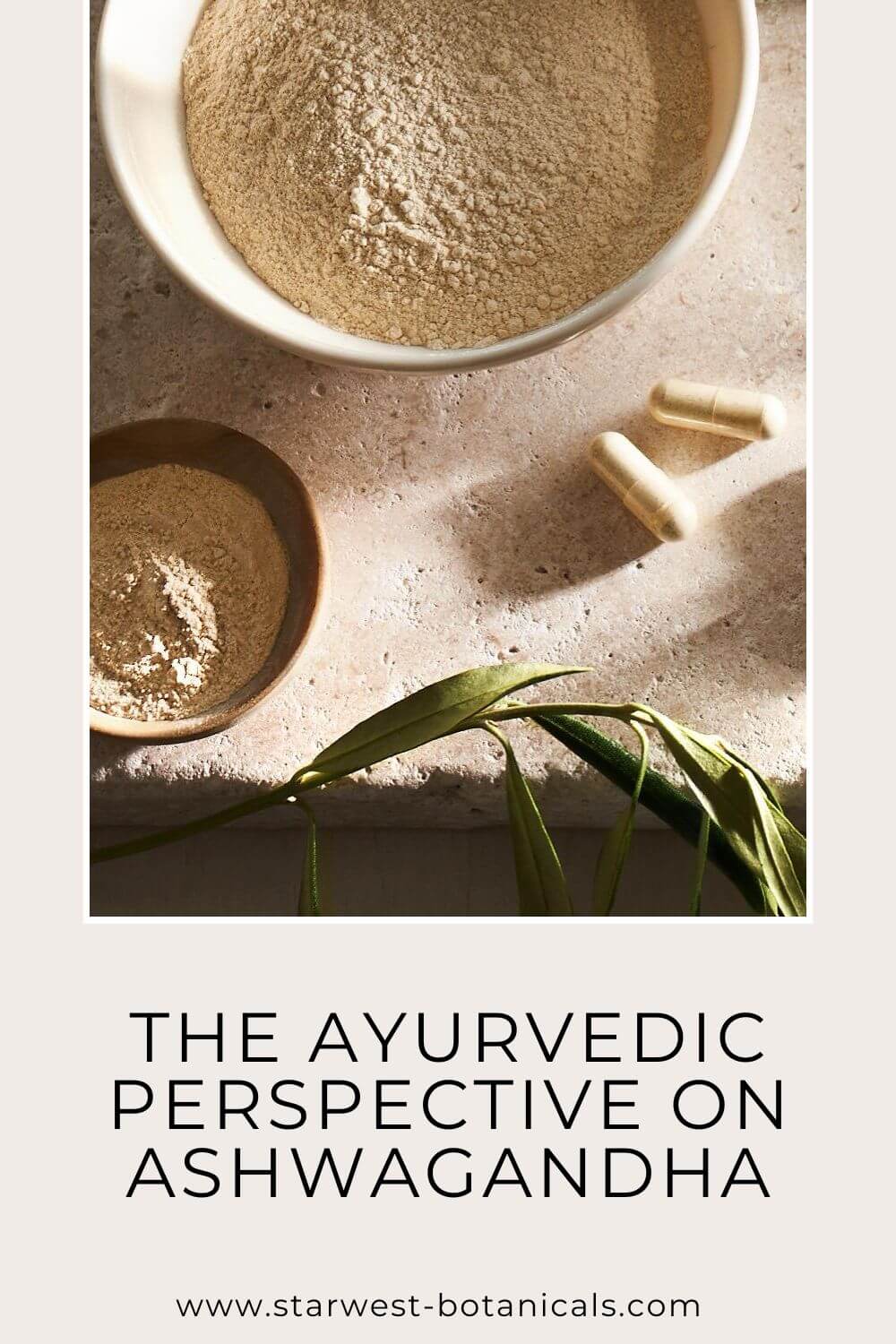When to Take Ashwagandha to Maximize Potential Benefits | Starwest Botanicals
Posted by Molly McConnell on 11-30-2023

The Ayurvedic Perspective on Ashwagandha
While ashwagandha has many benefits, it is most celebrated for its powerful adaptogenic properties, which can help the body modulate stress. This wonderful herb has also become a symbol of vitality, energy and virility. The root word “ashva” means horse in Sanskrit, which speaks to the vigor and strength that ashwagandha has the potential to call forth within us.
Ashwagandha has a heating action that gives it the potential to be energizing or activating. On the flip side, it also embodies unctuous, stable and slow qualities that can make it have a more calming effect. Depending on what your body needs and when you take it, you may experience either outcome. The same qualities that make ashwagandha calming, also help balance the wind element (or vata dosha) within us.
When harvesting this plant for herbal medicinal usage, the ashwagandha root is dug up, then dried, and often ground into a powder. Coming from beneath the earth, ashwagandha has the potential to evoke a deeply grounded quality in those who take it.
In Ayurvedic herbalism, Ashwagandha root is considered to be bitter and astringent in taste, with a sweet post-digestive effect. The tastes, heating or cooling action, and medicinal qualities of herbs are always taken into consideration when crafting a Ayurvedic remedy. In fact, herbs like ashwagandha are most commonly used in blends with other herbs to create a more synergistic and balanced effect. When you meet with an Ayurvedic Practitioner, you’ll almost always find that they recommend a custom tailored herbal formulation for you, rather than just one specific herb. This way, you’ll be receiving herbal medicine that supports your inherent constitution (prakruti) and your present imbalances (vikruti), as well as the season and the climate that you live in.
When preparing to ingest a natural remedy, Ayurveda always reminds us to tune into WHO is taking the herb(s) and HOW and WHEN to incorporate it in a way that will be most effective.
If you’re curious about weaving ashwagandha into your life, use the following list to understand when it will be a good fit for you. When you’re ready to try it, head over to 3 Natural Remedies with Ashwagandha to learn more about how to take it and what other herbs or substances to pair it with for the greatest impact.
When to Take Ashwagandha
- After a cleanse
- During cool weather
- If you have a vata (air + space) constitution
- When times are stressful
- For sleep challenges
Now, let’s unpack each of these so you are better equipped to understand why and how ashwagandha may be particularly beneficial for you at different times.
#1 AFTER A CLEANSE
Ashwagandha is a building substance. If you have toxic accumulation (aka ama) in your body, ashwagandha will build on that, creating more toxic sludge that can clog the channels to result in indigestion and breakouts. The best time to weave ashwagandha into your routine is when the digestive system is relatively clean and clear. This way, the building and strengthening energy of ashwagandha has a solid, healthy foundation from which to generate more energy and vitality.
After an Ayurvedic Cleanse, digestive fire should be robust. Because ashwagandha is a heavy and dense substance, strong and steady digestive fire is important to effectively absorb and assimilate all its potent healing energy so that you can get the maximum benefits.
One way to tell if your body is ready for ashwagandha after a cleanse is to check your tongue. In the morning when you wake up, look in the mirror and notice if you have a thick white-ish coating on your tongue. If you do, this is a sign of toxic buildup and you should not take ashwagandha. If your tongue is relatively clear or the coating is very light, you are ready to try it!
#2 DURING COOL WEATHER
Ashwagandha, also known as winter cherry, is more of a cold weather supplement. It has very heating properties that can help bring warmth and energy to the body when used appropriately. If used during hot weather, ashwagandha may trigger headaches and irritability. In the height of summer, opt for a combination of tulsi and rose instead.
#3 IF YOU HAVE A VATA (AIR + SPACE) CONSTITUTION
If you’re familiar with the ancient wisdom of Ayurveda, you know that there are three constitutions or mind body types based on the elements. These constitutions are called vata, pitta and kapha. Vata is a combination of the air and space elements. Pitta is a combination of fire and a little bit of water. Kapha is a combination of water and earth. Each constitution lends itself to certain characteristics and physical attributes.
Those with a vata (air + space) constitution, tend to embody qualities that emulate the wind. While vata people are very creative and imaginative, they are also prone to more frequent anxiety, insomnia, and ungroundedness. Because ashwagandha embodies such grounding qualities, it can be very soothing and balancing to vata-type people.
The bitter and heating aspects of ashwagandha can also be beneficial to kapha dosha (water + earth) constitutions, though a person with high amounts of kapha may actually prefer something lighter (like moringa or even shilajit).
Typically, ashwagandha should be avoided by those who have excess pitta dosha(fire) because it is much too heating and can actually lead to further imbalance.
#4 WHEN TIMES ARE ARE STRESSFUL
Ashwagandha is a star herb when it comes to helping the body and mind navigate stress. It has the potential to instill a sense of calm, promote restful sleep and even soothe a racing mind. If you notice your stress levels spike as you gear up for this holiday season, ashwagandha may be a perfect ally for you.
With its rejuvenative and nourishing qualities, ashwagandha has the potential to help us move through challenging times with greater ease and resilience*.
Just remember to avoid taking this herb if you have a thick coating on your tongue, which can be especially common as a result of heavy holiday dining. In this case, opt for digestive herbs, like ginger + chamomile tea, until that tongue coating clears up.
#5 FOR SLEEP CHALLENGES
If stressful or chaotic days start to bleed into sleepless nights, ashwagandha may be able to help. When you get into bed and notice a rise in anxiety or racing thoughts, Ashwagandha may
be of service in promoting restful sleep — especially if taken with warm milk in the evening. In this case, it is recommended to add herbs like cardamom, cinnamon and nutmeg to the ashwagandha milk for that balancing and synergistic effect.
Please note, Ashwagandha is not advised for long-term use. Do not take it for more than three months consecutively without a break. Additionally, avoid taking ashwagandha with androgenic conditions (such as PCOS), hyperthyroidism, or while pregnant. It is best to avoid ashwagandha during teenage years as well.
At Starwest Botanicals, we take pride in being your trusted source for an array of organic ashwagandha varieties. We offer Ashwagandha Root Powder, Ashwagandha Root Cut and Sift, Ashwagandha Root Extract, and Ashwagandha Root Capsules. Beyond ashwagandha, we carry a comprehensive selection of organic herbs and spices essential for Ayurvedic recipes.

Bio
Molly McConnell is a Certified Ayurvedic Practitioner who is committed to cultivating collective wellness. Guided by curiosity, embodied listening, and the rhythms of nature, Molly’s approach to Ayurveda is intentional and intersectional. As the cofounder of Cultivate Balance, she supports purpose-oriented people to come home to their bodies and restore resilience through nourishment, ritual, and routine. For a more immersive experience, Connect with Molly 1:1 or check outThe Reset for Resilience.
Instagram/Tiktok
Website



